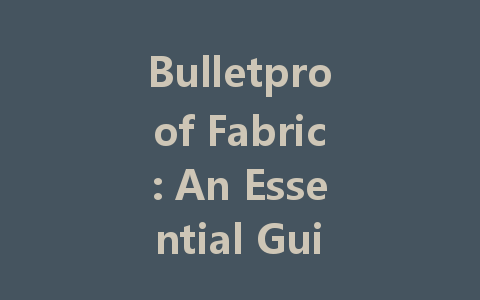In today’s world, safety and protection have never been more crucial. With advancements in technology, bulletproof fabrics have become a go-to solution for personal and public safety. This article will guide you through the process of choosing the appropriate bulletproof fabric, ensuring that you make an informed decision tailored to your needs.
Understanding Bulletproof Fabrics
What Are Bulletproof Fabrics?
Bulletproof fabrics are specialized materials designed to absorb and dissipate the energy from bullet impacts. Typically made from synthetic fibers such as aramid or polyethylene, these fabrics are engineered to provide protection without compromising comfort and mobility. The evolution of bulletproof technology has led to lighter, more flexible options suitable for various applications.
The Importance of Choosing the Right Fabric
Selecting the appropriate bulletproof fabric can mean the difference between life and death in critical situations. Understanding the different types of bulletproof materials available can help consumers make choices that align with their needs—whether for personal safety, law enforcement, or military applications.
Types of Bulletproof Fabrics
Aramid Fiber
Aramid fibers, like Kevlar, are among the most commonly used materials in bulletproof vests. They are lightweight yet offer high tensile strength, making them effective in stopping bullets. Aramid fibers also have excellent abrasion resistance, prolonging the lifespan of protective gear.
Ultra-High-Molecular-Weight Polyethylene (UHMWPE)
Known for its impressive strength-to-weight ratio, UHMWPE is another popular choice for bulletproof applications. It is lighter than aramid fibers and can be manufactured into hard armor plates, providing versatile options for users.
Steel and Ceramic Plates
While not classified as fabrics, steel and ceramic plates are often used in conjunction with bulletproof fabrics in tactical gear. They offer additional protection against higher caliber rounds but can add weight and reduce comfort.
Factors to Consider When Choosing Bulletproof Fabrics
Weight and Comfort
The weight of the bulletproof fabric is crucial for wearability, especially if it will be worn for extended periods. A heavier fabric may provide greater protection but might also lead to fatigue. Striking a balance between weight and comfort will help ensure that the wearer will use the protective gear regularly.
Level of Protection
Different bulletproof fabrics offer varying levels of protection, classified according to standards such as the National Institute of Justice (NIJ) ratings. Consumers should assess potential threats and select fabrics accordingly, such as choosing Level II-A for handguns or Level III for high-velocity rifles.
Durability and Maintenance
Durability is vital for any protective equipment. Bulletproof fabrics should withstand environmental conditions and regular wear. Additionally, consider how easy the fabric is to clean and maintain, as this can affect its longevity.
Application Scenarios for Bulletproof Fabrics
Personal Safety
Bulletproof fabrics can be integrated into everyday clothing or accessories, providing individuals with discreet protection. Think of bulletproof backpacks or jackets that blend seamlessly with casual attire yet offer enhanced safety.
Military and Law Enforcement
For military personnel and law enforcement officers, bulletproof fabrics are essential components of their uniforms and gear. The garments must allow for full mobility while ensuring maximum protection in potentially hostile environments.
Traffic and Commercial Vehicles
Increasingly, bulletproof fabrics are used in the automotive industry, providing both personal and commercial vehicles with enhanced safety features. This application has gained popularity in high-risk areas where security threats are prevalent.
The Future of Bulletproof Fabrics
Innovations in Technology
Research and development in bulletproof fabric technology continue to advance. New materials and manufacturing techniques, such as graphene, are emerging to offer even lighter and more protective options.
Customization and 3D Printing
The trend of customization is making its way into the bulletproof fabric market. 3D printing technology allows for personalized protective gear that fits an individual’s unique body shape, maximizing both safety and comfort.
Conclusion
In summary, choosing the appropriate bulletproof fabric is paramount for individuals seeking enhanced protection. By understanding the types of fabrics available, considering their unique properties, and assessing your specific needs, you can make a well-informed decision. Whether for personal use or professional demands, investing in the right bulletproof fabric can dramatically enhance your safety and peace of mind.

